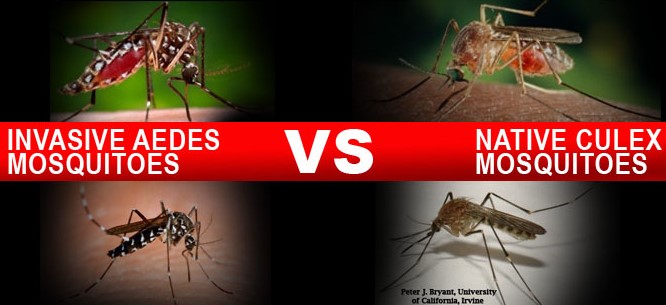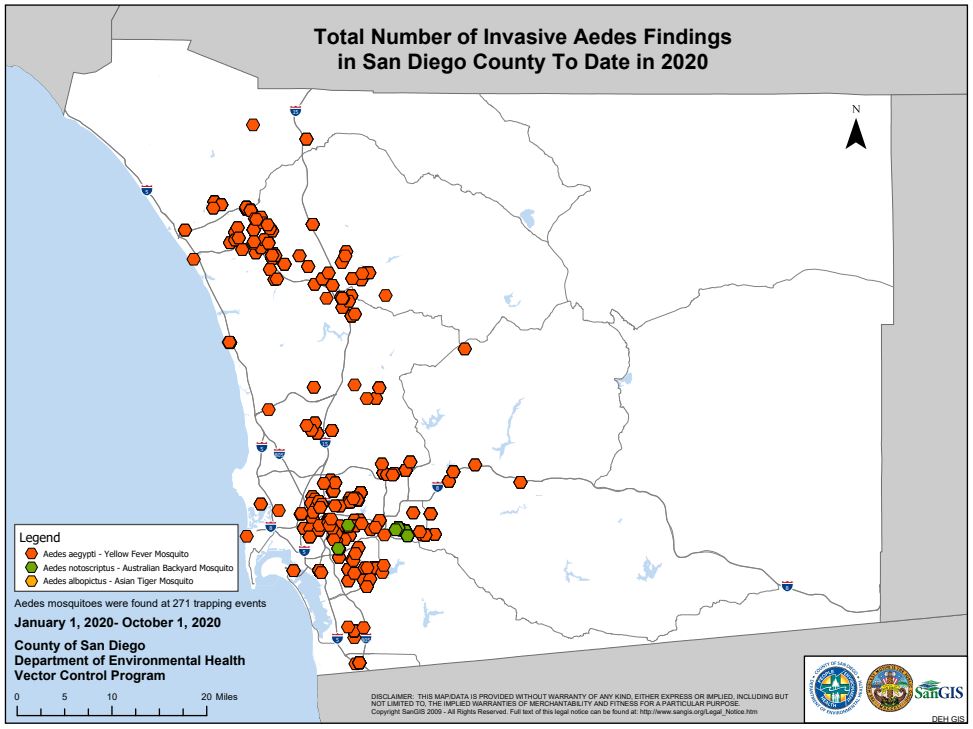If you find a patch of multiple mosquito bites, usually on your lower leg, you’ve most likely been fed on by an invasive Aedes mosquito.
Worldwide, there are approximately 3,000 species of mosquitoes, and nearly 4 million people die each year from various mosquito-borne diseases. In San Diego County there are 27 different types of mosquitoes, with at least nine types known to carry diseases that can be passed to humans.
The best defense against mosquito-borne disease is to avoid mosquito bites. You can reduce contact with mosquitoes by taking the following actions:
- Prevent mosquito breeding sources in your backyard and neighborhood by eliminating standing water
- Wear light colored pants and long-sleeved shirts, when outdoors
- Apply repellent containing DEET, Picaridin, IR3535, Para-menthane-diol, 2-undecanone, or Oil of Lemon Eucalyptus to clothing and exposed skin – When using sunscreen, apply repellents after applying sunscreen
- Try to stay indoors during dawn and dusk
- Apply screens to doors and windows and keep them well maintained to prevent mosquitoes from entering the home
- Stock ornamental ponds and other standing water sources with mosquito fish

Invasive Aedes | Native Culex | |
| Aedes aegypti: yellow fever mosquito Aedes albopictus: Asian tiger mosquito | Name, Species | Culex Tarsalis: western encephalitis mosquito Culex Quinquefasciatus: southern house mosquito |
| Transmitting tropical diseases like Zika virus, dengue, chikungunya, yellow fever — by first biting an infected person, then someone else. | Best Known For | Transmitting West Nile virus — by first biting an infected bird or animal, then biting a person. |
| Invasive — Hail from the tropics. First found in San Diego County in 2014 and 2015. | Origin | Native |
| Smaller than our native mosquitoes, and “pretty” (you know, for a mosquito) with distinctive black and white markings | Size, Markings | Culex tarsalis is a little bigger than the Aedes species, but also has black and white stripes. Quinquefasciatus is dull grey in color. |
| YOU. People are definitely their preferred menu item, but they’ll also feed on other critters as well. | Favorite Food | They prefer birds — birds and animals. But they will bite people too. |
| Daytime. Big difference between Aedes and culex mosquitoes. Aedes like to bite during the day. They’ll also bite around dusk and dawn, but rarely at night, when culex mosquitoes are munching. | Favorite Time to Bite | Mostly between dusk and dawn — definitely at night. They don’t bite during daylight hours. |
| Inside your house! In your yard! These guys love to live in urban and suburban areas — right next to you! | Hangouts | Outside. They’ll come inside your home if you let them, through a torn window screen or an open door. But you’re going to run into them most often outside — playing, hiking, picnicking, gardening; near stagnant streams, creeks, or bird baths, Koi ponds, fountains and stagnant pools. |
| Aedes like to breed around people, in homes or in yards, in small amounts of water like in tree holes or the saucers under flower pots. Their eggs can go six months without water — then get submerged by water from rain or sprinklers and boom! Instant mosquito larvae. A week later, mosquitoes! | Where they Breed | Culex lay 200 to 300 eggs at a time in rafts on stagnant water sources. |
| The prevailing wisdom is that Aedes aren’t strong fliers, with flight ranges of about 150 yards or so. | Estimated Flight Range | Culex Tarsalis can fly up to five miles. Culex quinquefasciatus is not as strong a flier, traveling up to 1/2 mile or so. |
| Prevent, Protect, Report — with heavy emphasis on the Prevent side. Empty out all standing water inside and outside your home so Aedes can’t breed. Report to Vector Control if you’re getting bitten during daylight hours. | Best Defense | Prevent, Protect, Report —Report to Vector Control if you know water sources where mosquitoes are breeding. Wear insect repellent, long sleeves and long pants when out around dusk and dawn. |

Invasive Aedes Mosquitoes
Aedes aegypti (the yellow fever mosquito) and Aedes albopictus (the Asian tiger mosquito) have been detected in the County of San Diego since 2014/2015. These mosquitoes are not native to California and can transmit the viruses that cause Zika, dengue, chikungunya, and yellow fever. There have been no recent cases of these viruses being transmitted locally in California. Aedes notoscriptus (the Australian Backyard Mosquito) has also been detected in San Diego. All three invasive Aedes mosquitoes bite aggressively during the day and lay their eggs in small containers of water.

Mosquito Facts:
- A mosquito has four stages of life:
Egg: Once laid in water, eggs will hatch in 2 to 3 days.
Larva: A mosquito larva looks like a tiny wiggling worm in the water.
Pupa: A larva becomes a pupa and the adult mosquito develops inside.
Adult: Total development time from egg to adult can be less than 1 week during periods of warm weather. The average mosquito will live for about 2 weeks. - Mosquitoes do not swarm
- Females suck blood (males don’t, they eat nectar)
- Native Culex mosquitoes can transmit West Nile virus and bite during dusk and dawn
- Invasive Aedes aegypti mosquitoes bite during the day and can transmit Zika virus if they bite someone with the virus and then bite someone else
- Invasive Aedes mosquitoes are aggressive biters, biting multiple times in one setting, both indoors and outdoors, especially during the day
Contact San Diego County Vector Control at [email protected] or 858-694-2888 to report possible Aedes activity, mosquito breeding or high mosquito activity, to request an inspection, and other vector-related issues.
Source: County of San Diego Department of Environmental Health




